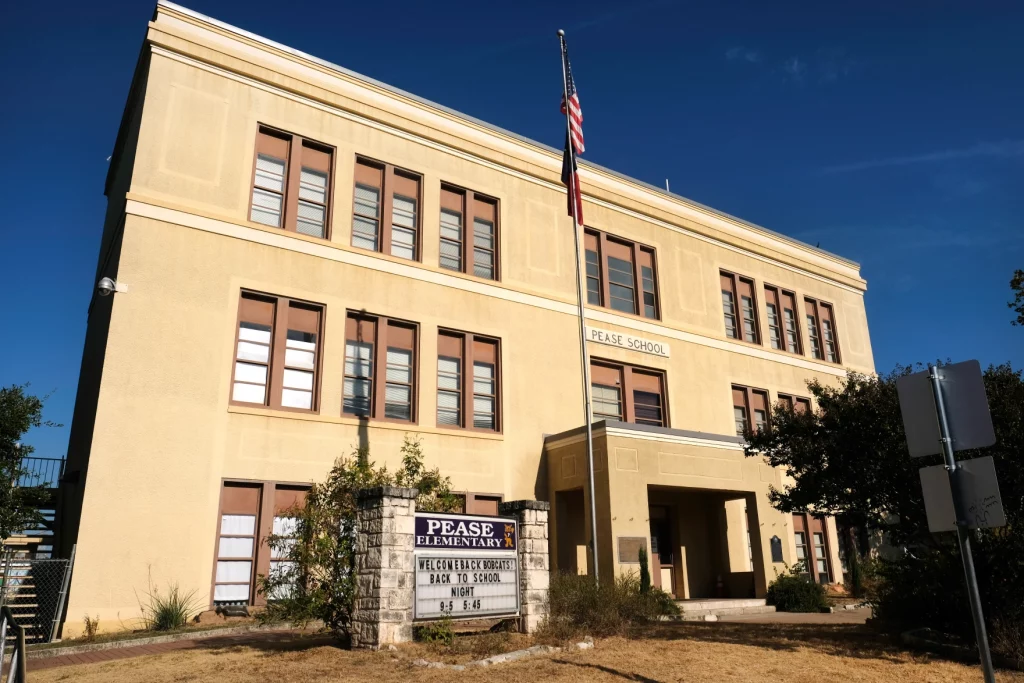Austin ISD is considering turning two properties into teacher and staff housing
Wednesday, September 21, 2022 by
Becky Fogel, KUT Austin ISD is considering turning two of its properties into housing that teachers and other staff could afford as rising housing costs make it harder to retain and recruit employees.
District officials have been holding public meetings on proposals for the Anita Ferrales Coy Facility in East Austin, the former Rosedale School in Central Austin, and Pease Elementary in downtown Austin, which closed in 2020.
Jeremy Striffler, Austin ISD’s director of real estate, said it’s important to the district to invest in the three sites by finding new ways of using them.
“Whether or not a campus is actively being used, it has value to us as an asset in terms of how we can serve the community,” he said. “And it’s something we’ve been really challenging ourselves to think about in the past few years.”
Creating workforce housing
Austin ISD wants to convert the Anita Ferrales Coy Facility and Rosedale School into housing staff can afford. The district has been zeroing in on affordable housing as one way to retain employees because its salaries are not keeping up with the rising cost of living.
“We think every day about how do our actions impact our students?” Striffler said. “So, being able to attract and retain quality teachers, that impacts our students.”
Over the summer, AISD advocated for $50 million to be included for teacher housing in the 2022 bond package, but some were concerned because the plan included few concrete details. Striffler said the district didn’t want housing to distract from other parts of the bond package, so it ultimately withdrew its recommendation.

“We do have other ways to achieve this goal of building high-quality housing that’s affordable for our teachers and our staff relative to their wages,” he said.
One way is to find partners to help develop housing on property the district already owns. In years past, Austin ISD sold properties, like the Baker School, primarily to private entities.
“To that end, we see it as a long-term investment, a long-term partnership. We’re not looking to sell these properties and just hand them off to the highest bidder,” Striffler said. “We’re looking to be a long-term partner and maintain ownership of these sites.”
AISD has proposed four different options for the former Rosedale School. One is to build 50 single-family homes on 25 lots. Another option is to build 44 two-story townhomes along with a four-story apartment building with 80 units. In all of the scenarios, Austin ISD would own the housing units and rent them out.
The proposals drew strong reactions during a virtual meeting about the property last week. While turnout for the public meeting was low, several of the people who attended expressed strong opposition to building an apartment complex at the site. While single-family homes would match the character of the neighborhood, they argued, an apartment complex would not. Another concern was that apartments would increase traffic in the area.
Striffler said the pushback is challenging because there is a strong need for housing Austin ISD employees can afford.
“It’s important to listen to all the feedback and take that into consideration as we think how best to move forward,” he said, “but I think what’s sometimes missing is folks being able to separate what’s serving them and what’s serving the greater good.”
Austin ISD has proposed five different housing options for the Anita Ferrales Coy Facility. The first three scenarios consist of building multiple apartment complexes and leaving more than 5 acres of park space. Other options include single-family homes and townhomes in addition to apartment buildings.
Striffler said it’s important to the district to offer housing that can accommodate families, especially as newer buildings in Austin market to young professionals.
“The sites ultimately we anticipate would have a mix of incomes, but also a mix of sizes in terms of number of bedrooms,” he said.

Jorge Sanhueza-Lyon/KUT. The district could turn Pease Elementary into affordable spaces for artists and arts organizations.
Pease is unique
Pease Elementary in downtown Austin is one of four schools the Austin ISD Board of Trustees voted to close in 2019. The district has less flexibility with the site, because the state of Texas requires the campus to serve an educational purpose.
With that in mind, AISD officials have proposed three different uses for Pease. One is to turn it into an early childhood center that provides discounted or free services to low-income families. A second option is to create a cultural arts campus that provides affordable spaces to artists and arts organizations. A third possibility is using the campus for administrative purposes. That could include relocating the Library Media Services Department, for example.
At a virtual meeting on the site earlier this month, several attendees supported repurposing the campus as an early childhood center.
“There are so many reasons I think this one is the best choice,” David Smith, CEO of United Way for Greater Austin, said. “We know that Austin has a great need for more child care.”
He was one of a number of people connected to United Way who attended the meeting. A former Pease parent raised concerns about the contingent of United Way employees at the meeting. She asked Striffler whether the district was holding a public meeting for show but had already decided to partner with United Way on an early childhood center.
Striffler responded that while AISD does believe an early childhood center would be the most beneficial to the district, that option has not been settled on nor has a specific partner been chosen.
Remaining meetings
Austinites who want to give feedback on the proposals can fill out a survey by Oct. 9 or attend one of the two remaining public meetings:
- Pease: Wednesday, Sept. 21, 6 p.m., via Zoom
- Anita Ferrales Coy: Wednesday, Sept. 28, 6 p.m., at the facility, 4900 Gonzales St.
Striffler said it’s vitally important for people to participate in this process so all opinions are heard.
“What we’re working toward is to establish the criteria for the site, so we need that input,” he said. “Not only to hear reasons for why people are against it, but we also need for those who are for it, for them to help us continue to shape what it could look like.”
This story was produced as part of the Austin Monitor’s reporting partnership with KUT.
The Austin Monitor’s work is made possible by donations from the community. Though our reporting covers donors from time to time, we are careful to keep business and editorial efforts separate while maintaining transparency. A complete list of donors is available here, and our code of ethics is explained here.
You're a community leader
And we’re honored you look to us for serious, in-depth news. You know a strong community needs local and dedicated watchdog reporting. We’re here for you and that won’t change. Now will you take the powerful next step and support our nonprofit news organization?






